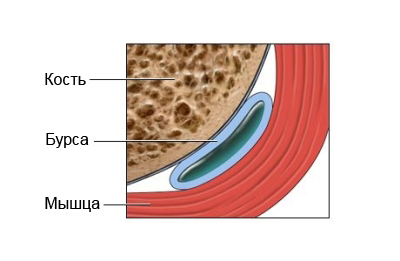Baker's cyst – Popliteal cyst
Description Baker's cyst
Baker's cyst – localized accumulation of synovial fluid (joint fluid) below the knee. This leads to excessive swelling of the bursa in this place. Bursa – filled with liquid bag, which reduces friction (resulting movement of joints) between the tendons, muscles and bones.

The cause of the Baker cyst
The exact cause of Baker's cysts is unknown. Half of the cases occur in children, as painless bulge behind the knee, which is particularly evident when the knee is straightened. This type of cyst can occur even in normal condition of the knee joint.
Other types of Baker's cysts arise due to illness and injury, which cause swelling and / or damage to the knee joint, including:
- Arthritis / osteoarthritis is the most common type of the disease, associated with Baker's cysts;
- Tears Cartilage, such as a torn meniscus;
- Injury or accident;
- Effusion of joint.
Risk factors
The following factors increase the likelihood of cyst Baker:
- Osteoarthritis;
- Rheumatoid arthritis;
- Past knee injuries or cartilage tears.
Symptoms of Baker's cysts
Baker's cyst may exhibit no symptoms. The following are the most common symptoms of a Baker cyst. However, their presence does not necessarily indicate the presence of a cyst Baker, and it may be associated with other diseases:
- Rounded swelling behind the knee about the size of a table tennis ball;
- Pain or pressure in the rear of the knee joint, that can go in calf muscles;
- Pain or soreness after exercise and bending the knee.
Diagnosis of a cyst Baker
The doctor asks about the symptoms and medical history. During the medical examination the doctor will look for a soft mass in the back of the knee, and explores the range of motion of the knee. To clarify the diagnosis can be performed the following tests and procedures:
- Diaphanoscope – bright light is passed through a cyst, to see the liquid filling of the popliteal region;
- Ultrasound and computed tomography – tests, useful in finding other causes of knee swelling;
- MRT – test, which uses magnetic waves, to make pictures of structures inside the body. It can be helpful to visualize the cyst and to detect meniscus injury;
- X-rays can be performed (arthrography). Baker's cyst will not appear on the picture, but it may show the presence of arthritis or other deviations knee.
If the cyst is growing rapidly and accompanied by fever, They may be taken blood samples, to look more serious types of tumors, which may occur under the knee.
Treatment of Baker's cysts
Most do not require any treatment, since many Baker's cysts disappear on their own within two years. In severe cases, treatment may include:
- Draining excess knee fluid
- Medication to relieve pain and inflammation, such as nonsteroidal anti-inflammatory drugs (NSAIDs);
- Recreation and lifting your feet on the rise;
- The use of physiotherapy, to help strengthen tendon;
- Taking pain;
- Wearing an elastic bandage (eg, Knee Brace);
- To remove large cysts and restoring meniscus tear surgery is needed;
- Aspiration (team) fluid with a needle. Especially significant positive effect seen in children;
- Steroid injections into the joint.
Prevention Baker cyst
Currently, methods of prevention are unknown Baker cyst.
